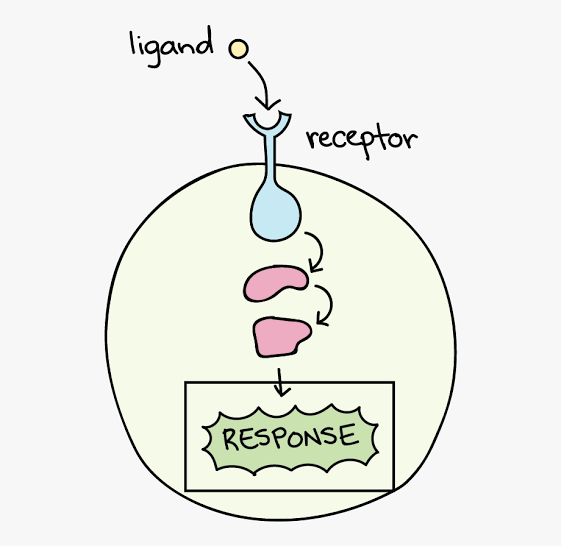হোস্টেলের বারান্দায় বসে একমনে কি যেন ভাবছে সোমা।
নিরা: কিরে সোমা, কি এতো ভাবছিস বল তো?
সোমা: নারে, ফেসবুকে একটা লেখা দেখলাম,
“তুমি হবে receptor, আমি হবো drug,
দু’জনে মিলে করবো বাজিমাত।”
কিন্তু এই drug এর সাথে receptor এর কি সম্পর্ক বুঝতে পারছিনা!
নিরা: এই ব্যাপার! শোন, আমাদের body তে drug অনেকভাবে কাজ করে, তার মধ্যে অন্যতম হচ্ছে এই receptor এর মাধ্যমে।
সোমা: তাই নাকি? একটু details এ বল তো বান্ধবী।
নিরাঃ আচ্ছা। প্রথমেই আসি Receptor বলতে আমরা কি বুঝি?
Receptors are special macromolecules present in our body on which different ligands work.
সোমা: Ligand কী বান্ধবী?
নিরা: Ligands are chemical substances which can combine with receptors.
e.g. drugs, hormones, neurotransmitters, toxins etc.
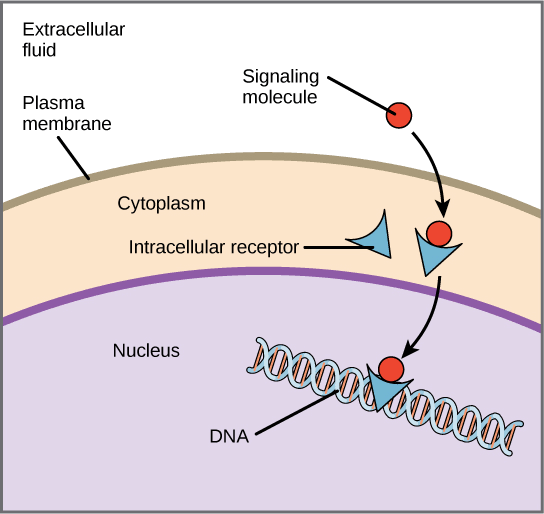
এখন, আমরা যখন কোনো drug নেই তখন তা এই receptor এর সাথে bind করে, ফলে signal formation হয় যা পরবর্তীতে biological effect করে।
সোমা: মানে, drug যাদের সাথে bind করবে তারা সবাই receptor?
নিরা: না, Receptor তারাই যারা drug binding এর পর biological action করে। যেমন ধর, plasma protein। এরা কিন্তু receptor না। কারণ এরা biological action করতে পারে না।
সোমা: আচ্ছা। এই receptor গুলো ঠিক কোথায় থাকে?
নিরা: Receptor গুলোর situation অনুযায়ী আমরা এদের ২ ভাগে ভাগ করতে পারি-
1. Receptors on surface of the cell:
Large molecular weight substance,
যেমন:
– Peptide hormones (Insulin, Growth hormone, Prolactin, Follicle stimulating hormone etc),
– Acetylcholine,
– 5-hydroxytryptamine,
– Histamine etc.
অথবা,
highly polar substances (Catecholamines) can’t dissolve in lipid membrane of cell। তাই এদের receptor থাকে cell surface এ।
2. Receptors within the cell:
Small molecular weight substances,
যেমন:
– Retinoid,
– T3 (Triiodothyronine),
– T4 (Thyroxine) etc.
অথবা,
highly lipid soluble substances:
– Steroid hormone,
– Aldosterone,
– Vit D etc.
They can enter into the cell.তাই এদের receptor থাকে cell এর ভিতরে।
সোমা: বুঝলাম। এই যে receptor গুলো এরা কিভাবে কাজ করে?
নিরা: প্রথমেই আসি Receptors on surface of the cell এ। এদের ৩ ভাগে ভাগ করা যায়-
1. G-protein coupled receptor.
2. Enzyme linked receptor.
3. Ion channel coupled receptor.
◼ G-protein coupled receptor:
এদের এরূপ নামকরণের কারণ এরা কিছু unique type trimeric protein এর সাথে coupled অবস্থায় থাকে যাদের বলা হয় G-protein। এছাড়াও এদের seven pass receptor ও বলা হয়। Catecholamines, Acetylcholine, Prostaglandin, Histamine, Thyroid stimulating hormone ইত্যাদি এই receptor এর সাহায্যে কাজ করে।
প্রথমেই Ligand এসে receptor এর ligand binding domain/ extracellular domain এর সাথে bind করে।
⬇
Conformational changes occur in receptor
⬇
Signal goes to the intracellular/ effector domain
⬇
Activates G protein (which is attached with effector domain)
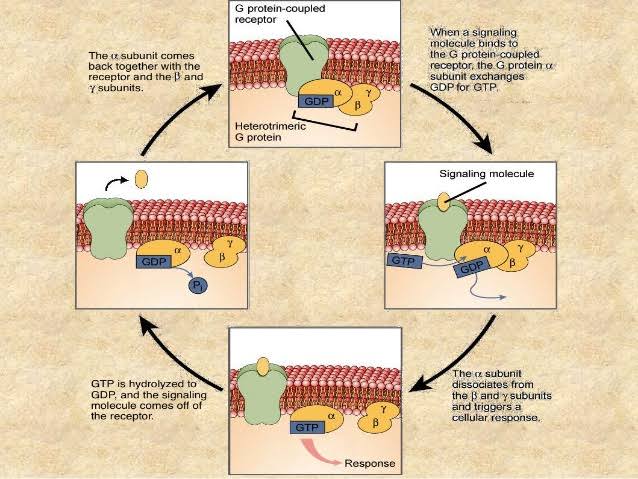
G-protein কে আবার ৩ ভাগে ভাগ করা যায়।
– Gs (stimulatory G-protein)
– Gi (Inhibitory G-protein)
– Gq (Stimulatory but not direct stimulatory as Gs)
✴ Gs:
G protein এর ৩ টি subunit থাকে (alpha, beta & gamma)। এরা G protein inactive অবস্থায় একসাথে bind করে থাকে এবং alpha subunit এর সাথে GDP bind থাকে।
কিন্তু G -protein activate হলে alpha subunit, beta & gamma subunit থেকে আলাদা হয়ে যায় এবং alpha subunit এর সাথে GDP (Guanosine diphosphate) কে সরিয়ে GTP (Guanosine triphosphate) এসে bind করে।
⬇
Alpha-GTP complex interacts with a target protein, adenylyl cyclase & activates it.
⬇
Causes formation of cAMP (Cyclic adenosine monophosphate) from ATP (Adenosine triphosphate)
⬇
cAMP activates protein kinase
⬇
Causes-
– Phosphorylation of intracellular protein
– Phosphorylation of transcriptional factor & causes altered genomic action
– Activation of ion channel (Ca++ channel)
✴ Gi:
এক্ষেত্রে alpha-GTP complex, Adenylyl Cyclase কে inhibit করে।
⬇
Decrease cAMP
অপরদিকে, beta-gamma complex K+ channel কে activate করে (efflux of K+)।
✴ Gq:
এক্ষেত্রে alpha-GTP complex, Phospholipase C কে activate করে।
⬇
এই activated Phospholipase C, cell membrane এর একটি unique protein এর উপর কাজ করে যার নাম PIP2 (Phosphatidyl inositol diphosphate)।
⬇
Production of DAG (Diacylglycerol) & IP3 (Inositol triphosphate) from PIP2.
✔ DAG activates Protein kinase C
⬇
Causes Phosphorylation as before.
✔ IP3 acts on special pump on Endoplasmic reticulum.
⬇
Release of Ca++ into cytosol
⬇
এই Ca++, Calmodulin এর সাথে bind করে Ca++ -Calmodulin complex তৈরি করে।
⬇
Activates Protein kinase (Ca Calmodulin kinase)
⬇
Works same as before
◼ এবার আসি Ion Channel coupled receptor এ।
এ ধরনের receptor গুলোতে multiple peptide chain একত্রে cluster আকারে থাকে (5 polypeptide subunit)। এই peptide গুলোর মাঝে কিছু unique pocket থাকে। Ligand এসে এ pocket গুলোকে stimulate করে।
এর ফলে receptor এর conformational change হয়।
⬇
signal goes to intracellular domain
⬇
As a result central transmembrane ion channel opens & transmembrane conduction of relevant ion occurs.
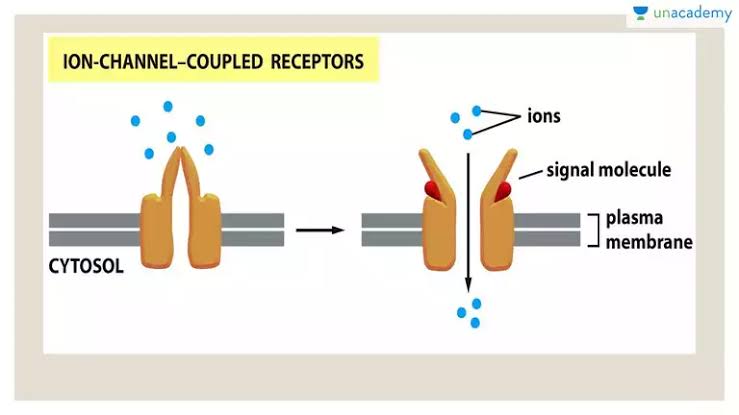
এদের আমরা ৩ ভাগে ভাগ করতে পারি।
1. Ligand gated ion channel
2. Voltage gated ion channel
3. Mechanical gated ion channel
✴ Ligand gated ion channel:
এদের আমরা ২ ভাগে ভাগ করতে পারি:
1. Excitatory neurotransmitter gated ion channel
2. Inhibitory neurotransmitter gated ion channel
✔ Excitatory neurotransmitter gated ion channel:
★ Nicotinic cholinergic receptor (can be stimulated by Ach or nicotine)
★ Muscarinic Cholinergic receptor (can be stimulated by Ach or muscarine)
★ 5HT3 receptor
★ Glutamate receptor (voltage + ligand gated)- present in hippocampus.
✔ Inhibitory neurotransmitter gated ion channel:
★ GABA receptor (present throughout the CNS)
★ Glycine receptor (mainly in spinal cord)
◼ Enzyme linked receptor:
এদের one pass receptor ও বলা হয়। এদের মধ্যে রয়েছে-
1. Tyrosine kinase receptor
2. Tyrosine kinase associated receptor
3. Tyrosine phosphatase receptor
4. Serine threonine kinase receptor
5. Guanylyl cyclase receptor
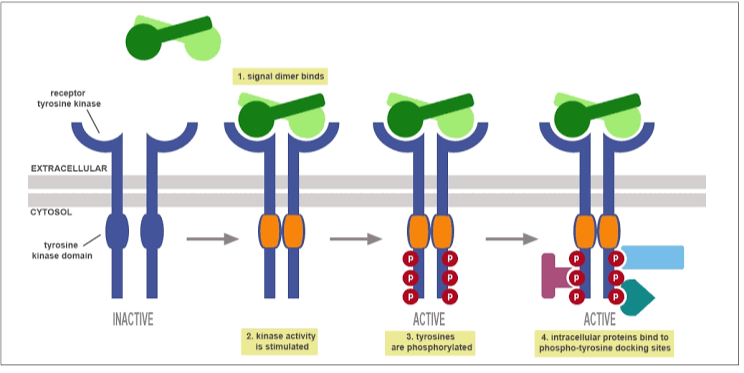
★Tyrosine kinase receptor:
Insulin, Epidermal growth factor, nerve growth factor, platelet derived growth factor, fibroblast growth factor ইত্যাদি এই receptor এর ligand হিসেবে কাজ করে।
Ligand এসে extracellular domain এ bind করার ফলে signal চলে যায় intracellular domain এ।
এই receptor এর intracellular domain এ cytoplasmic enzyme Tyrosine kinase যুক্ত থাকে। এবং এর সাথে tyrosine amino acids attached থাকে। যখনই signal এসে intracellular domain এর tyrosine kinase কে activate করে, তা সাথে থাকা tyrosine এর Phosphorylation করে ফেলে। একে বলা হয় autophosphorylation।
⬇
Then another group of protein (sulfhydryl protein) এসে phosphorylated tyrosine এর সাথে bind করে activated হয়।
⬇
Activates SOS protein (son of sevenless protein)
⬇
এই SOS protein এরপর RAS protein কে activate করে।
⬇
This RAS protein will loose GDP & acquire GTP.
⬇
Activates RAF (Rapidly Accelerated Fibrosarcoma) protein kinase.
⬇
Activation of MAP kinase (Mitogen activated protein kinase).
⬇
Causes Phosphorylation of transcription factor.
⬇
Transcription
⬇
Translation
⬇
Growth phenomenon
★ Tyrosine kinase associated receptor:
GH, Prolactin, IL-2, cytokine ইত্যাদি এ receptor এর মাধ্যম কাজ করে। এ ধরনের receptor এর unique property হলো, এখানে ligand একসাথে দুইটি receptor এর সাথে bind করে, যাকে বলে dimerization। এদের কোন intrinsic kinase activity নেই। অন্য আরেকটি enzyme এসে bind করে যাকে বলে Janus kinase/ JAS।
Activated JAS causes cross Phosphorylation of tyrosine residues.
⬇
Phosphorylated tyrosine residues interact with STAT protein & activate it, which acts as signal transducer & activator of transcription
⬇
এই activated STAT protein, receptor থেকে আলাদা হয়ে নিজেরা bind করে nucleus এ translocate হয়।
⬇
Stimulates gene which causes transcription.
⬇
Same as before
Notes:
✴ Cholinergic receptor:
– Nicotinic receptor (Ion channel receptor)
– Muscarinic receptor
✔M1 & M3 (Gq)
✔ M2 (Gi)
✴ Adrenergic receptor:
– alpha 1 (Gq)
– alpha 2 (Gi)
– beta 1 (Gs)
– beta 2 (Gs)
– beta 3 (Gs)
✴ Dopaminergic receptor:
– D1 (Gs)
– D2 (Gi)
✴ Purinergic receptor:
– A type (G protein coupled receptor)
– P type
– P1 & P2Y (G-protein coupled receptor)
– P2X (ligand gated ion channel coupled receptor)
✴ GABA receptor:
– GABA-A (ion channel receptor)
– GABA-B (G protein coupled receptor)
✴ TSH receptor (Gs)
✴ LH receptor (G protein coupled receptor)
✴ ACTH receptor (G protein coupled receptor)
✴ Rhodopsin receptor (G protein coupled receptor)
✴ Opioid receptor (G protein coupled receptor)
✴ Vasopressin receptor(G protein coupled receptor)
✴ Angiotensin 2 receptor (G protein coupled receptor)
✴ Oxytocin receptor (G protein coupled receptor)
সোমা: আচ্ছা। আর intracellular receptor কি কি আছে?
নিরা: Intracellular receptor গুলোকে ২ভাগে ভাগ করতে পারি:
1. Receptors in cytoplasm
2. Receptors in nucleus (e.g. T3, Retinoid)
✴ Receptor in cytoplasm আমরা STD দিয়ে মনে রাখতে পারি।
S- Steroid derivatives like estrogen, progesterone, testosterone, Aldosterone, glucocorticoid etc.
T- Thyroid hormone
D- Vit D
এবার আসি এরা কিভাবে কাজ করে।
এই receptor গুলোর ৩ টি domain থাকে-
– Ligand binding domain
– Transcription activating domain
– DNA- binding domain
DNA binding domain-টি heat shock protein (hsp 90) দিয়ে cover করা থাকে যা receptor কে inactive রাখে।
Ligand এসে ligand binding domain এর সাথে bind করার ফলে DNA binding domain কে cover করে রাখা hsp 90 release হয়ে যায় এবং domain exposed হয়।
⬇
translocate into nucleus
⬇
DNA binding domain এরপর enhancer region of DNA এর সাথে bind করে। অপরদিকে transcription activating domain, RNA polymerase এর মাধ্যমে transcription regulate করে।
⬇
transcription
⬇
Same as before
সোমা: অনেক ধন্যবাদ বান্ধবী। এখন থেকে তোর কাছে সব বুঝে নিবো।
নিরা: আচ্ছা, যাই রে এখন। ওয়াশরুমে সিরিয়াল দিয়ে এসেছি, পরে গেলে দেখবো কেউ ঢুকে গেছে!
সোমা: আচ্ছা।
Reference:
◼ Bertram G. Katzung: Basic & Clinical Pharmacology, 14th edition, McGraw-Hill Education, 2017.
◼ Laurence L. Brunton: Goodman & Gilman’s pharmacological basis of therapeutics, 13th edition, McGraw-Hill Education, 2018.
◼ John E. hall, Michael E. hall: Guyton & hall textbook of medical physiology, 13th edition, Elyse O’Grady, 2021.
Platform academic/ Diluwara Yasmin Priya (CeMeC, 16-17)

